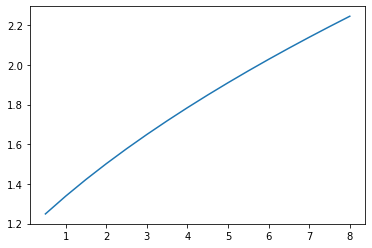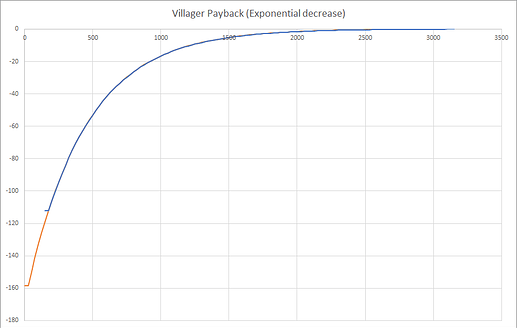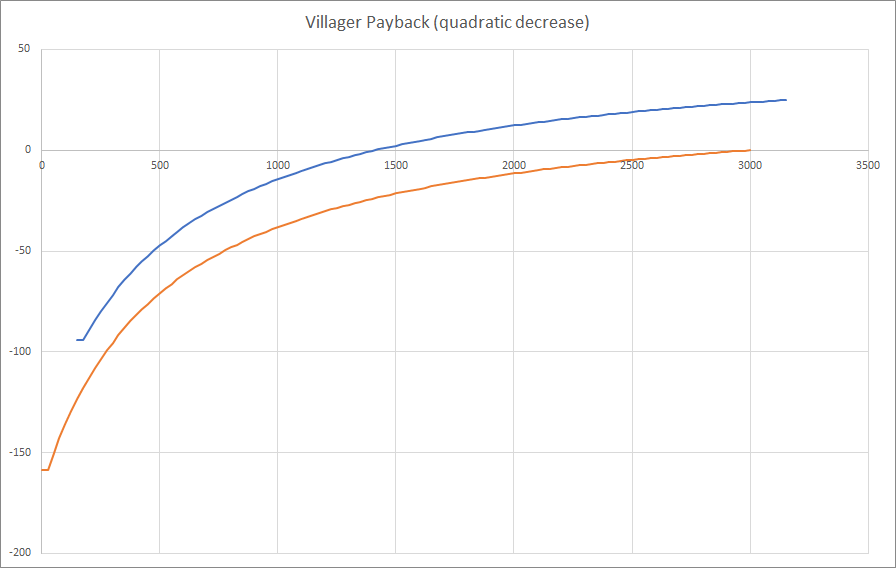Background:
I recently had a look into the cuman boom vs the malay boom. As I changed the builds to placing less farms and started market abuse, both became much faster and stronger. But opposed to the malay boom, the cuman boom had some limits with this strat. So I wondered about the early-game value of food, how much is it “worth” to buy from the market, so you could actually develop a booming strat for the cumans abusing it optimal so the castle time is not so far behind as it used to be without damaging the eco.
Problem:
How can you evaluate that. As the opposing strat to the market abuse is placing farms, which add a upfront investment and the food income is even worse than the other ressources. So there are 2 factors which should be evalueated:
A) Higher Value of Food
B) General loss of “value” of all ressources. 100 food at 5 min in the game are more valueable than 10 min into the game
To make it easy, I made a simple mathematical approach: For B) I assume a exponential decrease, looking for a “half-worth period” of the available ressources.
In Dark age it is somewhat easy, because the only 2 “eco investments” you can do there are vils and farms. So you have 2 different investments and 2 variants to find.
If I calculate this correctly I get a “half-worth period” of <= 4 mins and a food value factor of <= 1.78. If these would be changed abiove 4 mins and 1.78 factor it would automatically render farms better than vils, which for sure can’t be true.
In feudal it’s basically the same. With all upgrades in the variables would both be a bit higher, But I will come to this later, why this doesn’t matter for the boom approach. Of course only for the boom, if there is much fighting going on, this changes everything.
The real interesting thing is coming with Castle age and extra TCs. As extra TCs “pay back” their Investment in about 10 mins, this is the new value for the “half-worth period” (as the investment is given back the total worth of both timestamps would stay the same). With this taken into account and the new gather rates in castle age come into play, the “value factor” of Food raises to 2.01 whilst booming. But once you add military to this, the value will decrease drastically. So I actually think it’s better to never buy up to this number (201 G / 100 F) at the Market.
Also because of the value factor will fall anyway when the boom stops, this makes all farms less valueable than they might look whilst booming. The classical over-boom effect.
With these factors we can look into eco upgrades, farms and the market.
Always remember: These factors are only valid for a full boom without any disruption, in a practical game at least the real food factor will always be below the mentioned factors.
With the dark age factors, I calculated about 16 foresters to be worth upgrading double bit axe (16! foresters in feudal) and 22 farms until horsecollar pays of. So neither of these upgrades are actually worth it until you got castle age. With the Castle age factors double bit axe only takes 8 foresters and bow saw 13. So both are actually worth getting in early castle.
Farm Upgrades work even better: Horsecollar pays of after 7 farms, Heavy Plow after 9. But only if the factor stays at 2.01, which is rarely the case because the boom will occasionally stop. So here the theory can be a bit deceiving. But I think with like 12 farms both should already have paid of.
Anyhow, with these results in mind, it makes no sense to make any eco upgrades or farms in feudal (until aging up). Early farms can pay of, because the value they will give will raise during their lifetime, but feudal farms just delay your uptime because you could just abuse the market and get a faster uptime without damaging your eco in the aftermath. Here is how this works:
Dark/Feudal: 1300 F can be bought for 1987 G until exceeding 178F/100G For an total advantage of 184 F over placed farms. This is the pure advantage, much like the lithuanian food bonus. If the opponent goes for the same strat, the advantage needs to be halved, so it would be 92 F.
Early Castle Boom: 1900 can be bought for 2525 G until exceeding 201F/100G For an total advantage of 344 F over placed farms. If the opponent goes for the same strat, the advantage needs to be halved, so it would be 172 F.
As you can see 1900 F is a lot to work with, easily exceeding what you would usually have farmed when reaching castle for most games. Even 900 F (half the total amount) is a very high number, high enough to buy you to castle. But you need to be careful. If your opponent abuses the market earlier he can get an edge above you and if you don’t get the transition to the farm eco in early castle you will have big probs with your eco balance.
But for booming maps like arena/hifeout/fortress the no eco market abuse can easily pay off.
If we look at the special case of Saracens, the abuse potential is even bigger: 3100 F for 4705 G means a total advantage of 759 F over a pure farm eco. Even if the oponent is as fast as you in market abuse you would still get an advantage of 437 F over the farm boom until that, 265 more than the 172 F advantage the opponent gets via the abuse. I think it’s obvious why the saracens abuse is so powerful, the pure booming advantage is more than twice the other nations could get out of it.
But here’s the point: If this becomes “the play”, Saracens actually wouldn’t benefit the most. But Civs with the faster uptimes like lith, mongols, khmer or malay get the biggest advantage because they can build the market way before the opponent and take the best deals for their gold way earlier than the saracens (others). If Saracens only buy after the other civs already bought til 201 F / 100 G their advantage shrinks to 116 F. So the best counterplay against the Saracen Market abuse is to abuse it even before the Saracen player can abuse it as much as he wants to.
All the values I postet here are just for an orientation, in a real game they should be in general lower, because military is involved. The More military is involved, the less valueable food will become to be bought from the market. Keep this in your mind when trying to go for an strategy involving the market abuse. It can also sometime pay off to even exceeding the 201F/100G value occasionally, because non-idled TCs are still the most important ressource in booming.
But don’t make builds which would involve higher exchange rates. This is basically the edge of the market abuse potential for booming.
Also certain civs are different because their farming bonus:
Chinese
Teutons
(Sicilians)
Slavs
mayans
(khmer => faster uptime can even be better for more market abuse potential)
I didn’t have calculated the food values for these civs, but all should have slightly lower food values and therefore less market abuse potential compared to their other booming strats.
I haven’t played with this abuse yet, because I need to change a lot of my early game for this: earlier hunt, only a few buildings, no early farms, no feudal upgrades… It seems just wrong. I don’t even know how many vills would be the right amount to go up to fc with that strat, because it also depends if the opponent abuses the market, too. But I think I will occasionally try this in closed map at some time, where it could get me the edge in aging up and booming.
Possible strat could look like this: no mill but mining camp ff, market abuse, getting mill + certain eco upgrades on the way up to castle, full boom.
I think with certain civs like malay you could maybe even almost equal the cuman boom with the market abuse boom. Because the cuman player can’t get away with just market abuse then, he has to get the eco upgrades and farms early, where they don’t pay of as fast as in an fc boom.
In the aftermath the food value of 2 explains how valueable free food is. So for example the 400 free food of tatars is basically equal with +400 free ressources of any other kind. The Lithuanian 150 F from the start is equal with 300. The Mayans +15% even exceed the tatars bonus in this aspect because of the faster gather rate of deer and pork.
I will work on some builds how to make the best use of the market for booming. But as I don’t play boomy maps that freequent it may take a while until I can come up with it. I just wanted to share my research result, maybe someone else can find a way to use it in boomy maps or teamgames (may be difficult to abuse the market there ;)). The question is, if the 344 F advantage is worth learning completely new builds which are very vulnerable to any kind of disruption, go way into castle age and are also highly out-of-the-box. It’s not like how the sicilian first crusade abuse was almost impossible to beat in the boomy maps before the nerf.


